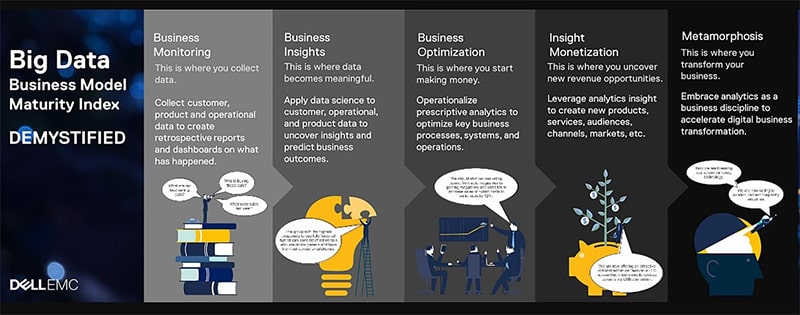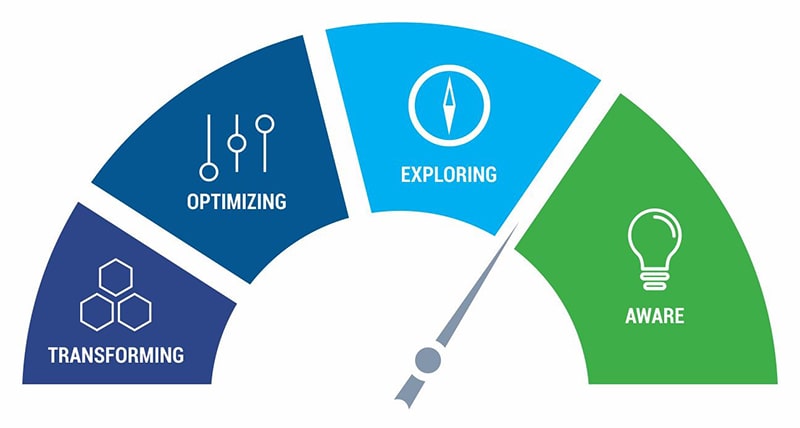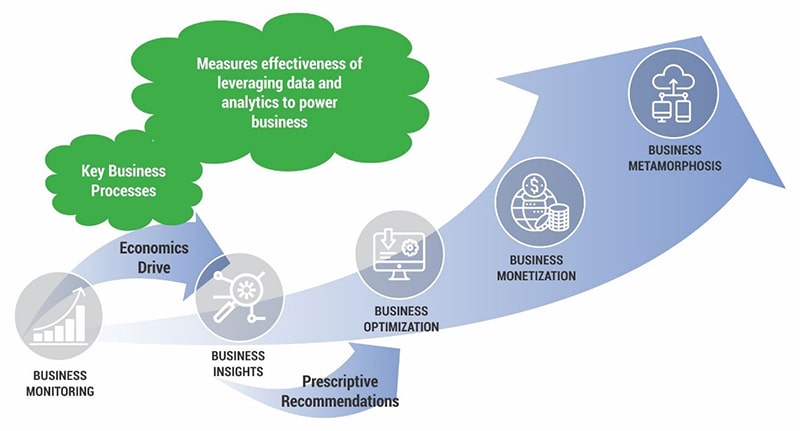
We’re living in the era where big data has achieved its rightful ubiquity as the most prominent technology trend in the post 2010s era, it is only natural to see the large platforms introduce their own models for the maturity index of this technology paradigm. Big data has crossed over from being a fringe technology for the mere insights into customer and stakeholder analytics, into a phenomenon that can easily be transformed into monetization and tangible outcome models. In fact, according to McKinsey, the largest trends are in moving away from mere descriptive analytics, where the past records and performance of the data and business were highlighted, to a more prescriptive model, where predictive analytics play a major role. In fact, according to the latest models developed by some of the world’s largest data analytics corporations, the key highlights of the business index maturity model in big data point to the following, expressed in the diagram below:

In the aforementioned, as per Dell EMC, the first stages of the BMMI start with business monitoring where customer product and operational data are gathered to form more prospective and prescriptive reports among the line of what has actually happened.
In the second stage, the data becomes more prescriptive in nature, gleaning out the key business insights that have been derived and also providing a wider scope on which data science in itself can be applied to customer and product data to derive more actionable insights and ultimately help in coercing the business outcomes.
In the third stage, the business analytics, and visualization thus gathered, is actually modelled as per the customer and user behavior to gain a greater sense of understanding on how to monetize the data to gain adequate actionables and identify new revenue opportunities for the data to be monetized and drive greater value for the business as a whole.
The final stage is where the entire business data model is metamorphosed to enhance customer data to drive business insights and intelligence and garner a position of greater revenue and competitive intelligence, thus successfully leading to the transformation of the enterprise as a whole in the marketplace.
Hortonworks proposes another similar enterprise level data maturity model, exemplified below:

This model stems from the awareness of the possibilities of using Big Data Analytics, and then moves on to exploring the capabilities and deploying a data infrastructure to suit the business needs. Optimization of the processing capabilities and value derivative capabilities are the next step, followed, of course, by the end goal- the transformation of the enterprise.
Dell EMC’s Data Maturity Model has several iterations of the optimization and enterprise transformation described above, and is represented as follows:

In this case, the model starts with the monitoring of business processes and key economic drivers, moving onto the identification of the key business processes where data analytics can enhance value addition. Recommendations drawn from the insights are then prescribed to optimize businesses, leading onto measurable monetization of the insights into tangible outcomes, and ultimately creating the business metamorphosis, or transformation.
Several technology giants have all proposed their own version of the big data maturity model index, but at the heart of all these processes are journeys towards the underlying goals of identifying key areas and processes within business and then tying them to the scope of data analytics. This is followed by a rigorous effort to glean the maximum value in terms of monetization from the insights gathered to finally result in organizational transformation based on the processing capabilities of the in-house data model.
Such models, that are increasingly being commoditized and adopted as a part of the intelligent, digitally transformed enterprise, are the need of the hour in an increasingly fragmented and disrupted technology world. This also means that organizations are increasingly seeking out skilled Data Scientists to adopt, streamline and seamlessly integrate these technology models within themselves, spurring a massive demand for skilled and certified Data Scientists. Get ahead with the world’s leading data science programs from the most respected certification authority in the data science world today!


































